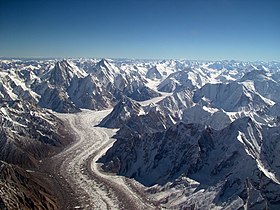Karakorum Mountains
| Karakoram | |
|---|---|

|
|
| Highest point | |
| Peak | K2 |
| Elevation | 8,611 m (28,251 ft) |
| Coordinates | 35°52′57″N 76°30′48″E / 35.88250°N 76.51333°E |
| Geography | |

Highest Karakoram peaks as seen from International Space Station
|
|
| Countries | |
| States/Provinces | Gilgit-Baltistan, Ladakh, Xinjiang and Badakhshan |
| Range coordinates | 36°N 76°E / 36°N 76°ECoordinates: 36°N 76°E / 36°N 76°E |
| Borders on | Pamir Mountains, Hindu Kush and Himalayas |
The Karakoram, or Karakorum is a large mountain range spanning the borders of Pakistan, India, and China, with the northwest extremity of the range extending to Afghanistan and Tajikistan. It is located in the regions of Gilgit–Baltistan (Pakistan-administered Kashmir), Ladakh (Indian-administered kashmir), and southern Xinjiang (China), and reaches the Wakhan Corridor (Afghanistan). A part of the complex of ranges from the Hindu Kush to the Himalayan Range, it is one of the Greater Ranges of Asia. The Karakoram is home to the four most closely located peaks over 8000m in height on earth:K2, the second highest peak in the world at 8,611 m (28,251 ft), Gasherbrum I, Broad Peak and Gasherbrum II.
The range is about 500 km (311 mi) in length, and is the most heavily glaciated part of the world outside the polar regions. The Siachen Glacier at 76 kilometres (47 mi) and the Biafo Glacier at 63 kilometres (39 mi) rank as the world's second and third longest glaciers outside the polar regions.
The Karakoram is bounded on the northeast by the edge of the Tibetan Plateau, and on the north by the Pamir Mountains. The southern boundary of the Karakoram is formed, west to east, by the Gilgit, Indus, and Shyok Rivers, which separate the range from the northwestern end of the Himalaya range proper as these rivers converge southwestward towards the plains of Pakistan.
...
Wikipedia
